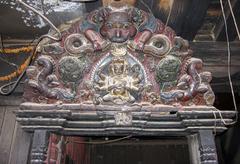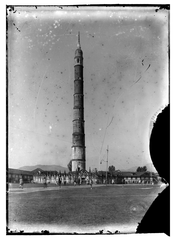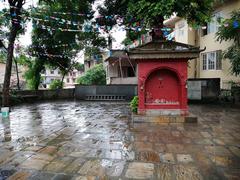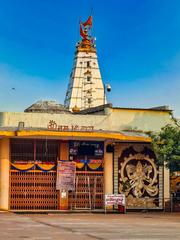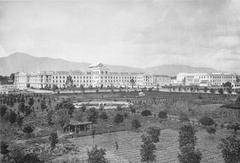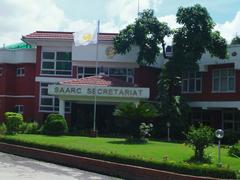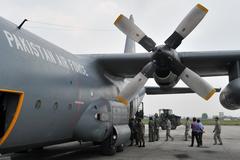
Comprehensive Guide to Visiting Kathmandu, Kathmandu District, Nepal
Date: 13/08/2024
Captivating Introduction
Imagine stepping into a land where history, culture, and spirituality converge in a harmonious symphony. Welcome to Kathmandu, the enchanting capital of Nepal, where every street corner holds tales of ancient civilizations and modern-day marvels. As you wander through this vibrant city, you’ll feel like you’ve been transported into a living, breathing museum that constantly evolves yet remains deeply rooted in its rich heritage.
Kathmandu’s history is a fascinating tapestry that stretches back over two millennia. From the Stone Age tools and brick walls unearthed at Hadigaon and Lubhu to the golden age of the Malla dynasty with its pagodas and intricately carved windows, the city is a testament to human ingenuity and resilience (Wikipedia). Picture yourself standing in Kathmandu Durbar Square, surrounded by the grandeur of ancient palaces and temples, each narrating a chapter of the city’s storied past.
But Kathmandu is not just about the past. It is a living, breathing metropolis where traditional festivals like Dashain and Tihar paint the streets with joy and color, and where modern adventures like paragliding and bungee jumping offer a thrilling contrast to the city’s historical allure (Rugged Trails Nepal). Whether you’re exploring the hidden gems of Asan Market or savoring the unique flavors of Newari cuisine, Kathmandu promises an unforgettable journey for every traveler.
So, pack your bags and get ready for an adventure that will captivate your senses and enrich your soul. Let’s dive into the heart of Kathmandu and uncover its secrets, one story at a time.
Table of Contents
- History and Significance of Kathmandu
- Cultural Heritage of Kathmandu
- Must-Visit Attractions in Kathmandu
- Kathmandu Durbar Square
- Swayambhunath Stupa (Monkey Temple)
- Pashupatinath Temple
- Boudhanath Stupa
- Patan Durbar Square
- Thamel
- Garden of Dreams
- Kopan Monastery
- Bhaktapur
- Nagarkot
- Changu Narayan Temple
- Dakshinkali Temple
- Chandragiri Hills
- Everest Mountain Flight
- Tundi Khel
- Tribhuvan Museum
- Seto Machindranath Temple
- Asan Market
- Taudaha Lake
- National Museum of Nepal
- Call to Action
History and Significance of Kathmandu
Ancient Kathmandu Valley
Did you know Kathmandu’s history stretches back to ancient times, with archaeological finds dating between 167 BC and 1 AD? Imagine Stone Age tools and brick walls unearthed at Hadigaon and Lubhu—early evidence of human activity in this valley. It’s like opening a time capsule to a world long forgotten (Wikipedia).
Licchavi Kingdom (400–750 AD)
During the Licchavi period, Kathmandu started to shine. Picture two adjoining settlements, Yambu and Yangal, merging to form Kantipur, a city shaped like Manjushri’s sword! It had eight fortified barracks guarded by Ajimas. Think of it as Kathmandu’s early version of a superhero squad (Wikipedia).
Transitional Kingdom (750–1200 AD)
Fast forward to the transitional phase (750–1200 AD), and you’ll find King Gunakama Deva planning the city with temples dedicated to the eight mother goddesses. Even the Kasthamandap, a wooden pavilion that gave Kathmandu its name, was built during this period. Imagine the buzzing activity as artisans chiseled wood and laid bricks (Wikipedia).
Malla Dynasty (1200–1768 AD)
The Malla dynasty brought Kathmandu into a golden age of culture and architecture. Imagine pagodas, intricately carved windows, and open-air shrines popping up all over the city. But the 14th century wasn’t all smooth sailing; invaders like the Khasa king Ripumalla and Sultan Shams ud-din Ilyas of Bengal left their mark, leading to widespread reconstruction. It’s like a medieval version of urban renewal (Wikipedia).
In 1484, the Malla kingdom split into three—Kathmandu, Bhadgaon, and Patan. This led to a fascinating era of architectural one-upmanship, with each kingdom striving for grandeur. Picture a breathtaking skyline of temples and palaces competing for attention (Wikipedia).
Shah Dynasty and Unification (1768–1951 AD)
Enter Prithvi Narayan Shah in 1768, who unified Nepal and ushered in the Shah dynasty. Kathmandu continued its growth, adding landmarks like the Narayanhiti Royal Palace. The Shah dynasty’s rule lasted until Nepal’s monarchy was abolished in 2008. It’s a tale of power, politics, and enduring legacy (Wikipedia).
Modern Era and Earthquake of 2015
Kathmandu has gracefully blended its rich history with modernity, despite the 7.8 magnitude earthquake in April 2015 that damaged many historical buildings. Restoration efforts are ongoing, ensuring the city’s legacy lives on. It’s a testament to the resilience and spirit of its people (Wikipedia).
Cultural Significance
Kathmandu is a cultural melting pot, home to numerous UNESCO World Heritage Sites. Here are some must-visit spots:
Kathmandu Durbar Square
This hub of historical and cultural significance is surrounded by ancient palaces, courtyards, and temples like the Hanuman Dhoka Palace and the Kumari Ghar, where a living goddess resides. It’s like stepping into a living museum (Nepal Traveller).
Swayambhunath Stupa (Monkey Temple)
Ever wondered what it’s like to have breakfast with monkeys? Head to Swayambhunath Stupa, a hilltop site offering panoramic views of Kathmandu. Its white dome and golden spire are iconic symbols of the city. Don’t forget to bring a banana or two (Nepal Traveller).
Pashupatinath Temple
Situated on the Bagmati River’s banks, this is Nepal’s most sacred Hindu temple. The gold-plated roof and silver doors make it a stunning example of Nepalese architecture. Feel the spiritual energy as you walk through its ancient halls (Nepal Traveller).
Boudhanath Stupa
This massive stupa is a significant pilgrimage site for Buddhists. Surrounded by a vibrant Tibetan community, it’s filled with monasteries, shops, and restaurants. It’s like a mini-Tibet in the heart of Kathmandu (Wanderlog).
Hidden Gems and Unique Experiences
Apart from the famous spots, Kathmandu has several hidden gems waiting to be discovered:
Garden of Dreams
An oasis in the bustling city, the Garden of Dreams offers a serene escape with its neoclassical architecture, fountains, and lush greenery.
Asan Market
Experience the local vibe at Asan Market, where you can find everything from spices to traditional crafts. It’s a sensory overload you won’t want to miss.
Interactive Elements
Challenge: Kathmandu Selfie Scavenger Hunt
Why not make your visit more interactive? Challenge yourself to a selfie scavenger hunt. Snap photos at iconic sites and hidden gems, and share your journey with friends and family.
Visitor Tips
- Respect Local Customs: Dress modestly and remove shoes before entering temples and stupas.
- Hire a Guide: Gain deeper insights by hiring a local guide.
- Stay Hydrated: Carry water, especially in the summer months.
- Be Prepared for Crowds: Popular sites can get crowded. Plan your visit accordingly.
- Support Local Artisans: Buy handmade souvenirs to support traditional crafts.
Local Lingo
Learn a few local phrases to enhance your experience:
- Namaste: Hello (pronounced nah-mah-stay)
- Dhanyabad: Thank you (pronounced dah-nyah-bahd)
- Sasto: Cheap (pronounced sahs-toh)
- Mitho: Delicious (pronounced mee-tho)
Seasonal Highlights
Kathmandu offers unique experiences throughout the year:
- Spring (March-May): Enjoy the vibrant colors of the Holi festival.
- Summer (June-August): Experience the monsoon magic with lush green landscapes.
- Autumn (September-November): Witness the grand celebrations of Dashain and Tihar festivals.
- Winter (December-February): Explore the city in a cooler climate and enjoy local winter delicacies.
Myth Busting and Surprises
Many believe Kathmandu is just about temples and history, but did you know it’s also a hub for adventure sports like paragliding and bungee jumping? Kathmandu is full of surprises!
Storytelling Elements
Imagine walking through the narrow alleys of Thamel, hearing the legend of the Kathmandu Kumari, a living goddess chosen from the Newar community. It’s stories like these that make the city come alive.
FAQ
Q: What’s the best time to visit Kathmandu? A: The best time to visit is during the autumn months (September to November) when the weather is pleasant and festivals are in full swing.
Q: Is Kathmandu safe for solo travelers? A: Yes, Kathmandu is generally safe for solo travelers. Just take standard precautions like you would in any other city.
Q: What currency is used in Kathmandu? A: The currency used is the Nepalese Rupee (NPR).
Conclusion
Kathmandu is a living museum, offering a unique blend of past and present. Respect local customs and explore its many historical sites to truly appreciate this vibrant city. Download Audiala, our tour guide app, for beautifully crafted audio guides to enhance your exploration. Ready for your Kathmandu adventure? Let’s go!
Cultural Heritage of Kathmandu
Welcome to the Heartbeat of Nepal
If Kathmandu were a song, it would be an ever-changing melody that dances through time, blending ancient traditions with modern rhythms. Welcome to a city where history whispers through every alley, and vibrant festivals paint the streets with joy!
Historical Significance
Kathmandu, where history spans over two millennia, is a bustling hub that once connected India and Tibet. Picture merchants, scholars, and pilgrims converging in a melting pot of beliefs—Hinduism, Buddhism, and more—harmoniously coexisting in this valley. Imagine the stories that the Kathmandu Valley, including Patan and Bhaktapur, has to tell (Roaming Atlas).
Architectural Marvels
The Majestic Durbar Squares
Kathmandu’s crown jewels are its UNESCO World Heritage-listed Durbar Squares: Kathmandu, Patan, and Bhaktapur. These squares are treasure troves of palaces, temples, and intricate architecture that scream of a regal past (UNESCO).
- Kathmandu Durbar Square: Home to stunning Newari architecture, this square boasts the resplendent Kumari Ghar, where a living goddess resides. It’s like stepping into a real-life fairy tale (Roaming Atlas).
- Patan Durbar Square: Dating back to the 3rd century, Patan is known for its artistic flair. Imagine intricate woodwork, stone carvings, and a vibe that transports you to an era of kings and scholars (Roaming Atlas).
- Bhaktapur Durbar Square: A living museum of medieval art and architecture, this square is a majestic ode to the Malla dynasty (UNESCO).
Religious Sites
Swayambhunath Stupa (Monkey Temple)
Swayambhunath Stupa, aka the Monkey Temple, offers panoramic views of the Kathmandu Valley. Picture colorful prayer flags fluttering in the breeze, and monkeys adding a playful touch to this serene pilgrimage site (Nomadasaurus).
Boudhanath Stupa
Boudhanath Stupa isn’t just one of the largest in Asia; it’s a spiritual hub that buzzes with Tibetan culture. Imagine a sea of prayer wheels and the hum of monks chanting (Nomadasaurus).
Pashupatinath Temple
Pashupatinath Temple, dedicated to Lord Shiva, is a sacred haven on the banks of the Bagmati River. Picture a labyrinth of shrines and temples, and the somber rituals of cremations along the riverbanks (UNESCO).
Festivals and Celebrations
Kathmandu is a living, breathing celebration of life. Imagine the city as a kaleidoscope of festivals, each adding its own splash of color to the cultural canvas (Rugged Trails Nepal).
- Dashain: The grandest festival, celebrating the triumph of good over evil with family gatherings, sacrifices, and the worship of Durga.
- Tihar: Picture a five-day festival that lights up the city, honoring animals like crows, dogs, and cows, culminating in the worship of Laxmi.
- Buddha Jayanti: A celebration of Buddha’s birth, enlightenment, and death, marked by vibrant processions and prayers.
Cultural Etiquette
When in Kathmandu, do as the Nepali do! Respecting local customs will make your experience richer (Tourist Secrets).
- Greetings: Say “Namaste” with a smile, a slight bow, and joined palms. It’s a universal key to Nepali hearts.
- Dress Modestly: Cover your shoulders and knees, especially in religious sites. And don’t forget to remove your shoes!
- Photography: Always ask before snapping photos of people, and be mindful of restrictions in religious settings.
Local Cuisine
Dive into Kathmandu’s culinary delights, where every dish tells a story (Nomadasaurus).
- Momos: These dumplings are little pockets of joy, filled with meat or veggies and served with spicy sauce.
- Dal Bhat: The staple meal of lentil soup, rice, and a variety of side dishes is a culinary symphony.
- Newari Cuisine: Savor the unique flavors of Yomari (sweet dumplings), Chatamari (rice flour crepes), and Bara (lentil patties).
Hidden Gems and Local Secrets
- Garden of Dreams: An oasis of tranquility in the heart of the city, perfect for a quiet stroll or a romantic date.
- Asan Market: A bustling bazaar where you can find everything from spices to souvenirs—an authentic slice of local life.
- Pharping: A short trip from the city, this village offers serene monasteries and breathtaking landscapes.
Insider Tips
- Best Time to Visit: Spring (March-April) and autumn (October-November) offer the best weather (The Common Wanderer).
- Getting Around: Taxis and rickshaws are your best bet, but be ready for some chaotic streets (Practical Wanderlust).
- Health and Safety: Stay hydrated, mind the air quality, and make sure you’re insured and vaccinated (Tourist Secrets).
Conclusion
Kathmandu isn’t just a place; it’s an experience waiting to be lived. Dive into its rich heritage, marvel at its architecture, and lose yourself in its vibrant festivals. Download Audiala, your tour guide app, to explore Kathmandu like a local and discover its hidden wonders!
Must-Visit Attractions in Kathmandu
Embark on a journey through Kathmandu, where ancient temples and bustling bazaars blend seamlessly with the whispers of mountain breezes. Let’s dive into the heart of Nepal’s capital, an eclectic mix of history, culture, and vibrant life.
Kathmandu Durbar Square
First stop: Kathmandu Durbar Square, the crown jewel of Nepalese architecture. Imagine stepping back in time as you wander through this UNESCO World Heritage Site, where each temple and palace tells a tale from the 15th century. Marvel at the Hanuman Dhoka Palace, the mystical Kumari Ghar (home to the Living Goddess), and the towering Taleju Temple. Whether you’re a history buff or a culture enthusiast, this square is your gateway to Nepal’s royal past. Pro tip: Catch the local festivals here for a truly immersive experience! (source)
Swayambhunath Stupa (Monkey Temple)
Ready for a panoramic view of Kathmandu? Head up to Swayambhunath Stupa, fondly known as the MonkeyTemple. This sacred Buddhist site, with its iconic white dome and golden spire adorned with Buddha’s all-seeing eyes, offers not just spiritual solace but also breathtaking cityscapes. And yes, the playful monkeys add a dash of charm to your visit. As you climb the 365 steps, feel the serenity wash over you. (source)
Pashupatinath Temple
Dive deep into spirituality at the Pashupatinath Temple, perched on the banks of the sacred Bagmati River. This is no ordinary temple; it’s one of Hinduism’s holiest sites dedicated to Lord Shiva. Witness the mesmerizing cremation ceremonies and feel the spiritual energy that permeates the air. The temple’s pagoda-style architecture and rich religious rituals make it a profound experience. A tip: Visit during the Maha Shivaratri festival for an extraordinary spectacle. (source)
Boudhanath Stupa
Next, we visit the colossal Boudhanath Stupa, a haven for Tibetan Buddhists and a UNESCO World Heritage Site. Its massive mandala design and the watchful eyes of Buddha create a serene and contemplative atmosphere. Stroll around the stupa, spin the prayer wheels, and soak in the spiritual vibes. Don’t miss out on the rooftop cafes around the stupa for a peaceful tea break with a view. (source)
Patan Durbar Square
Just a short trip to Lalitpur, and you’ll find yourself in Patan Durbar Square, another UNESCO marvel. This square brims with Newar craftsmanship, from the Krishna Mandir to the Golden Temple. The ancient royal palace now doubles as a museum, perfect for history enthusiasts. Wander the square’s bustling lanes, filled with artisans and quaint cafes, to get a true taste of local life. (source)
Thamel
For a pulse on modern Kathmandu, Thamel is where you need to be. This tourist hub is alive with vibrant nightlife, bustling streets, and a myriad of shops and eateries. Whether you’re hunting for trekking gear, unique souvenirs, or a taste of Nepali cuisine, Thamel has it all. It’s the perfect place to mingle with fellow travelers and locals alike. (source)
Garden of Dreams
Need a break from the city’s hustle? The Garden of Dreams is your tranquil escape, a neo-classical garden in the heart of the city. Built in the early 20th century, it features European-inspired architecture, fountains, and pavilions amidst lush greenery. It’s an ideal spot for relaxation, reading, or a quiet afternoon amidst nature. (source)
Kopan Monastery
For those seeking peace and meditation, Kopan Monastery, set on a picturesque hilltop, is a must-visit. This Tibetan Buddhist monastery is not just a place of worship but a center for learning and meditation. Participate in meditation courses, attend teachings, or simply enjoy the serene surroundings. The monastery’s beautiful gardens and prayer halls offer a tranquil retreat. (source)
Bhaktapur
Step into a living museum at Bhaktapur, an ancient city just 13 kilometers from Kathmandu. This UNESCO World Heritage Site is a treasure trove of medieval architecture and vibrant culture. Wander through Bhaktapur Durbar Square, marvel at the 55-Window Palace, and explore the towering Nyatapola Temple. Don’t miss the local pottery and weaving shops, where you can see craftsmen at work. (source)
Nagarkot
For breathtaking views of the Himalayan range, including Mount Everest, Nagarkot is your go-to destination. Just 32 kilometers from Kathmandu, this hill station is famed for its stunning sunrises and sunsets over the mountains. Hike the various trails, breathe in the fresh mountain air, and enjoy the serene environment. It’s the perfect nature getaway. (source)
Changu Narayan Temple
One of Nepal’s oldest temples, Changu Narayan, is a masterpiece of Hindu architecture. Located 12 kilometers from Kathmandu, this UNESCO World Heritage Site is dedicated to Lord Vishnu. Explore the intricate wood and stone carvings and the surrounding village, which offers a glimpse into traditional Newari culture. (source)
Dakshinkali Temple
Dedicated to the fierce goddess Kali, Dakshinkali Temple, located 22 kilometers south of Kathmandu, is a site of intense spirituality and traditional rituals. Visit during the Dashain festival to witness the powerful animal sacrifices. The temple’s forested location adds to its mystical ambiance. Nearby, explore Pharping village with its Buddhist monasteries and meditation centers. (source)
Chandragiri Hills
For an exhilarating adventure, take a cable car ride to Chandragiri Hills, offering panoramic views of Kathmandu Valley and the Himalayas. At the hilltop, visit Bhaleshwor Mahadev Temple and enjoy various recreational activities. It’s also a popular spot for hiking and picnicking, blending adventure with relaxation. (source)
Everest Mountain Flight
If trekking to Everest Base Camp isn’t on your itinerary, the Everest Mountain Flight is a thrilling alternative. Soar close to Mount Everest and other majestic peaks for a breathtaking aerial view. The flights, lasting about an hour, depart from Kathmandu’s Tribhuvan International Airport. It’s a once-in-a-lifetime experience that shouldn’t be missed. (source)
Tundi Khel
Tundi Khel is a vast open ground in central Kathmandu, historically used for parades and public gatherings. Today, it’s a recreational spot for locals and visitors. Surrounded by landmarks like the Bhimsen Tower and Singha Durbar, it’s a great place to experience local culture and enjoy outdoor activities. (source)
Tribhuvan Museum
Within the Hanuman Dhoka Palace Complex lies the Tribhuvan Museum, dedicated to King Tribhuvan’s life and legacy. Explore artifacts, photographs, and documents that chronicle Nepal’s journey to democracy. It’s an insightful stop for anyone interested in modern Nepalese history. (source)
Seto Machindranath Temple
In the heart of Kathmandu stands the Seto Machindranath Temple, a revered site for both Hindus and Buddhists dedicated to Avalokiteshvara, or White Machindranath. The annual chariot procession, Seto Machindranath Jatra, is a vibrant event attracting thousands. The temple’s intricate architecture and religious significance make it a must-visit. (source)
Asan Market
Experience the hustle and bustle of Asan Market, one of Kathmandu’s oldest and busiest markets. Here, you can find everything from fresh produce to traditional spices, textiles, and handicrafts. It’s a sensory delight and a fantastic spot to immerse yourself in local life, try street food, and shop for unique souvenirs. (source)
Taudaha Lake
Just 6 kilometers south of Kathmandu lies Taudaha Lake, a serene escape surrounded by lush greenery. The lake is a haven for birdwatchers, attracting a variety of migratory and resident species. It’s perfect for a peaceful picnic or a leisurely walk along the shore. The tranquil setting makes it an ideal retreat from the city’s hustle. (source)
National Museum of Nepal
Explore Nepal’s rich history, culture, and art at the National Museum of Nepal in Chhauni, Kathmandu. The museum features three main buildings: the Historical Museum, the Buddhist Art Gallery, and the Juddha Jayatia Kala Shala. From ancient sculptures and paintings to historical documents, there’s much to discover. (source)
Call to Action
As you conclude your journey through the enchanting city of Kathmandu, you’ll find that it’s not just a destination but an experience that stays with you forever. From the ancient temples of Pashupatinath and Boudhanath to the bustling streets of Thamel and the serene Garden of Dreams, Kathmandu offers a unique blend of the old and the new, the sacred and the secular (Nomadasaurus).
The city’s resilience is evident in its ability to preserve its rich heritage despite challenges like the devastating earthquake of 2015. The ongoing restoration efforts are a testament to the indomitable spirit of the people of Kathmandu, ensuring that future generations can continue to marvel at its historical grandeur (Wikipedia).
Kathmandu is a cultural melting pot where diverse traditions coexist harmoniously, and every festival is a vibrant celebration of life. Whether you’re participating in a local ritual at Swayambhunath Stupa or enjoying a plate of momos at a street-side stall, the city’s charm is bound to leave you spellbound (Roaming Atlas).
So, are you ready to uncover the hidden gems and vibrant culture of Kathmandu? Download Audiala, your ultimate tour guide app, to get insider tips, expert insights, and a personalized guide to this enchanting city. Let Audiala be your companion as you explore the secrets and stories that make Kathmandu a truly magical place. Your adventure awaits!
References
- Wikipedia, 2023, Wikipedia contributors History of Kathmandu
- Nepal Traveller, 2023, Nepal Traveller contributors Historical Sites in the Kathmandu Valley
- Wanderlog, 2023, Wanderlog contributors Most Historic Buildings and Sites in Kathmandu
- Roaming Atlas, 2023, Roaming Atlas contributors Kathmandu Itinerary
- UNESCO, 2023, UNESCO contributors UNESCO World Heritage List
- Nomadasaurus, 2023, Nomadasaurus contributors Best Places to Visit in Kathmandu
- Rugged Trails Nepal, 2023, Rugged Trails Nepal contributors Festivals and Celebrations in Kathmandu
- Tourist Secrets, 2023, Tourist Secrets contributors Everything You Need to Know Before You Go to Kathmandu
- Britannica, 2023, Britannica contributors Kathmandu
- Detourista, 2023, Detourista contributors Guide to Kathmandu Attractions
- Thrillophilia, 2023, Thrillophilia contributors Places to Visit in Kathmandu
- Altitude Himalaya, 2023, Altitude Himalaya contributors Nepal Travel Bucket List 2024




